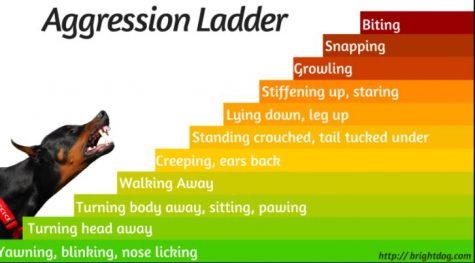
Six signs of aggression
May 17, 2017
Man’s best friend. The one that will be there for us when no one else is. The one that comforts you when you are down, who only wants a belly rub and some TLC. Dogs can be the miracle you need in your life, yet many people are afraid of them because of the aggressive behavior they show at times.

According to the ASPCA, these are the most common signs of aggression:
- A threatening sounding bark
- Lunging forward or charging
- Growling
- Showing teeth
- Bumping your body with their nose
- Becoming very still and rigid
There are different types of aggression. Dog owners need to ask these questions in order to understand the type: Who or what was the aggression directed toward? Where did it happen? When did it happen? Did something stop the aggression?
The answers to these questions will help provide insight into the reason for your dog’s aggression.
Territorial aggression occurs if a person enters the dog’s personal space unexpectedly. This could be someone the dog knows or an intruder in the house. Protective aggression can occur if the pet feels that its owner is in danger.
Possessive aggression occurs when the animal feels threatened over its belongings. It may guard its things heavily, and not allow anyone near them. Fear aggression occurs when pets feel cornered or trapped, and may attack due to their fight-or-flight instinct.
“Territorial and possessive aggression are the most common types of aggression. Dogs are domesticated creatures, so it makes sense that some of their wild instincts are still in their bones,” Jennifer Monroe, Veterinarian, said.
Pain-elicit aggression may occur when pets are in pain and lash out due to it. Social aggression can occur if a dog views itself as higher up in “status” in relation to other family pets.
Professional behavior experts are great tools to use when figuring out how to quell your dog’s aggression. All dogs can be aggressive, so do not shove it into the back of your mind if your Toy Pomeranian begins growling and showing its teeth. Pay attention to the signs.